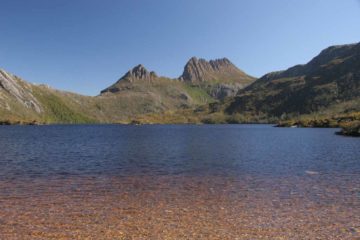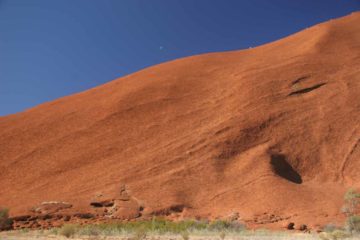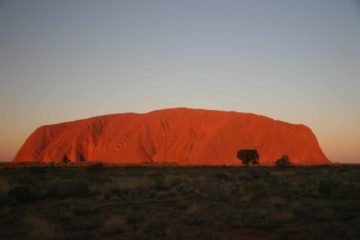About Nelson Falls
Nelson Falls was a gorgeous 30m high wall of water shaped like an inverted wine glass. Julie and I were very pleasantly surprised to see this waterfall pumping the way it did on our first visit, and perhaps it might have had to do with the rain we received the previous night while we were staying in Queenstown (some 27km to the west). In addition to the waterfall itself, the short walk took us through a temperate rainforest that was probably amidst the healthiest ecosystem we had encountered in both of our visits to this part of Tasmania. Not only were the ferns and mossy trees dripping with dew and displaying a vibrant green, but the flow of the Nelson River was also vigorous. Indeed, when the river was as voluminous as you see in the photo above, we were getting sprayed at the lookouts, which was something we couldn’t say about any other waterfall during our trips to Southeastern Australia in 2006 and later in 2017.
Even though the signs said it was merely a 700m 20-minute return walk to take in Nelson Falls, Julie and I spent about 40-45 minutes in both of our visits here. The track was flat pretty much the whole way with boardwalks set up in the most sensitive spots while meandering alongside the Nelson River. In sunny and warm weather (like on our second visit), there was ample forest cover to prevent the harsh sun from beating down on us. Overall, it was a relaxing stroll and one that rejuvenated us while breaking up the long drive between Queenstown and Hobart.
The interpretive signs along the track had us imagine we were in a time machine. By playing this mind game, we learned that this part of Tasmania was once under water, then later under ice, and then split up into neighbouring forests that would tectonically drift as far as New Zealand and even South America. Indeed, the species of fern that were along the walking track also happened to occur in those distant places attesting to the existence of the former Gondwanaland supercontinent. In fact, the primal and wild feel of the rainforest here was aided by its inclusion in the undeveloped Franklin-Gordon Wild Rivers National Park, which was part of the Tasmanian Wilderness World Heritage Area seeking to protect these ancient tracts of land. This reserve (dominating much of the western and southern parts of the state) was one of the largest contiguous tracts of undeveloped wilderness left in Tasmania.
Although the legislative protections helped to maintain the health of this area since the 1980s, we could see that prior efforts to find mineral riches as well as a way to traverse the boggy and rugged wilderness took its toll on the landscape as well as on the people looking for opportunities to earn wealth. In the 30+ years since the Tasmanian Wilderness World Heritage Area was established, we found ourselves in a far different place than what the old photos from the signs at the trailhead had shown as Nature quickly took back what had been undisturbed well before the advent of European settlement. Perhaps the enduring legacy of the human activity of the past was the current Lyell Highway. That road linking Queenstown and Hobart pretty much followed the Linda Track, which opened up exploration (and exploitation) to the west between the two towns.
Related Top 10 Lists
No Posts Found
Trip Planning Resources
Nearby Accommodations
This content is for members only. See Membership Options.Featured Images and Nearby Attractions
This content is for members only. See Membership Options.Visitor Comments:
Got something you'd like to share or say to keep the conversation going? Feel free to leave a comment below...No users have replied to the content on this page
Visitor Reviews of this Waterfall:
If you have a waterfall story or write-up that you'd like to share, feel free to click the button below and fill out the form...No users have submitted a write-up/review of this waterfall






